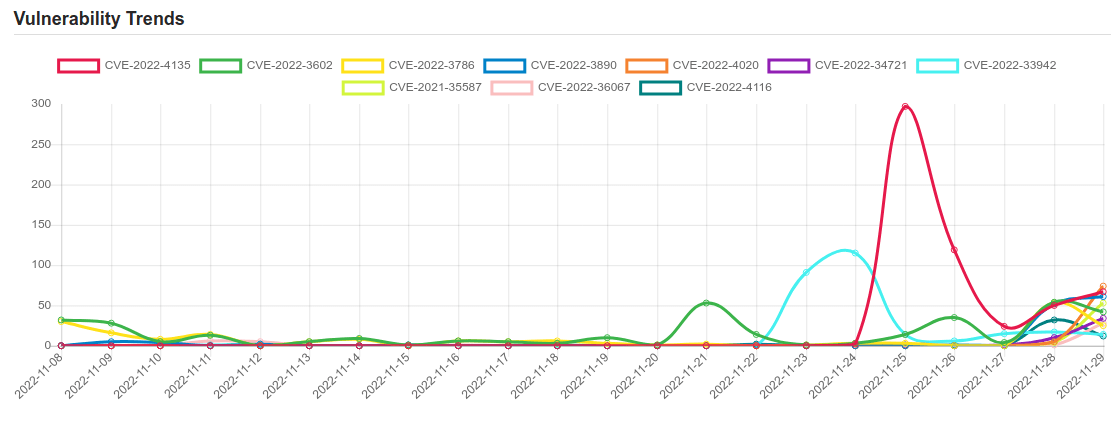Daily Vulnerability Trends: Wed Nov 30 2022

| CVE NAME | CVE Description |
| CVE-2022-40684 | An authentication bypass using an alternate path or channel [CWE-288] in Fortinet FortiOS version 7.2.0 through 7.2.1 and 7.0.0 through 7.0.6, FortiProxy version 7.2.0 and version 7.0.0 through 7.0.6 and FortiSwitchManager version 7.2.0 and 7.0.0 allows an unauthenticated atttacker to perform operations on the administrative interface via specially crafted HTTP or HTTPS requests. |
| CVE-2016-7098 | Race condition in wget 1.17 and earlier, when used in recursive or mirroring mode to download a single file, might allow remote servers to bypass intended access list restrictions by keeping an HTTP connection open. |
| CVE-2022-20465 | In dismiss and related functions of KeyguardHostViewController.java and related files, there is a possible lockscreen bypass due to a logic error in the code. This could lead to local escalation of privilege with no additional execution privileges needed. User interaction is not needed for exploitation.Product: AndroidVersions: Android-10 Android-11 Android-12 Android-12L Android-13Android ID: A-218500036 |
| CVE-2022-0698 | Microweber version 1.3.1 allows an unauthenticated user to perform an account takeover via an XSS on the ‘select-file’ parameter. |
| CVE-2022-45934 | An issue was discovered in the Linux kernel through 6.0.10. l2cap_config_req in net/bluetooth/l2cap_core.c has an integer wraparound via L2CAP_CONF_REQ packets. |
| CVE-2021-31693 | VMware Tools for Windows (12.x.y prior to 12.1.5, 11.x.y and 10.x.y) contains a denial-of-service vulnerability in the VM3DMP driver. A malicious actor with local user privileges in the Windows guest OS, where VMware Tools is installed, can trigger a PANIC in the VM3DMP driver leading to a denial-of-service condition in the Windows guest OS. |
| CVE-2022-4135 | Heap buffer overflow in GPU in Google Chrome prior to 107.0.5304.121 allowed a remote attacker who had compromised the renderer process to potentially perform a sandbox escape via a crafted HTML page. (Chromium security severity: High) |
| CVE-2022-3602 | A buffer overrun can be triggered in X.509 certificate verification, specifically in name constraint checking. Note that this occurs after certificate chain signature verification and requires either a CA to have signed the malicious certificate or for the application to continue certificate verification despite failure to construct a path to a trusted issuer. An attacker can craft a malicious email address to overflow four attacker-controlled bytes on the stack. This buffer overflow could result in a crash (causing a denial of service) or potentially remote code execution. Many platforms implement stack overflow protections which would mitigate against the risk of remote code execution. The risk may be further mitigated based on stack layout for any given platform/compiler. Pre-announcements of CVE-2022-3602 described this issue as CRITICAL. Further analysis based on some of the mitigating factors described above have led this to be downgraded to HIGH. Users are still encouraged to upgrade to a new version as soon as possible. In a TLS client, this can be triggered by connecting to a malicious server. In a TLS server, this can be triggered if the server requests client authentication and a malicious client connects. Fixed in OpenSSL 3.0.7 (Affected 3.0.0,3.0.1,3.0.2,3.0.3,3.0.4,3.0.5,3.0.6). |
| CVE-2022-3786 | A buffer overrun can be triggered in X.509 certificate verification, specifically in name constraint checking. Note that this occurs after certificate chain signature verification and requires either a CA to have signed a malicious certificate or for an application to continue certificate verification despite failure to construct a path to a trusted issuer. An attacker can craft a malicious email address in a certificate to overflow an arbitrary number of bytes containing the `.’ character (decimal 46) on the stack. This buffer overflow could result in a crash (causing a denial of service). In a TLS client, this can be triggered by connecting to a malicious server. In a TLS server, this can be triggered if the server requests client authentication and a malicious client connects. |
| CVE-2022-3890 | Heap buffer overflow in Crashpad in Google Chrome on Android prior to 107.0.5304.106 allowed a remote attacker who had compromised the renderer process to potentially perform a sandbox escape via a crafted HTML page. (Chromium security severity: High) |
| CVE-2022-4020 | Vulnerability in the HQSwSmiDxe DXE driver on some consumer Acer Notebook devices may allow an attacker with elevated privileges to modify UEFI Secure Boot settings by modifying an NVRAM variable. |
| CVE-2022-34721 | Windows Internet Key Exchange (IKE) Protocol Extensions Remote Code Execution Vulnerability. This CVE ID is unique from CVE-2022-34722. |
| CVE-2022-33942 | Protection mechanism failure in the Intel(R) DCM software before version 5.0 may allow an unauthenticated user to potentially enable escalation of privilege via adjacent access. |
| CVE-2021-35587 | Vulnerability in the Oracle Access Manager product of Oracle Fusion Middleware (component: OpenSSO Agent). Supported versions that are affected are 11.1.2.3.0, 12.2.1.3.0 and 12.2.1.4.0. Easily exploitable vulnerability allows unauthenticated attacker with network access via HTTP to compromise Oracle Access Manager. Successful attacks of this vulnerability can result in takeover of Oracle Access Manager. CVSS 3.1 Base Score 9.8 (Confidentiality, Integrity and Availability impacts). CVSS Vector: (CVSS:3.1/AV:N/AC:L/PR:N/UI:N/S:U/C:H/I:H/A:H). |
| CVE-2022-36067 | vm2 is a sandbox that can run untrusted code with whitelisted Node’s built-in modules. In versions prior to version 3.9.11, a threat actor can bypass the sandbox protections to gain remote code execution rights on the host running the sandbox. This vulnerability was patched in the release of version 3.9.11 of vm2. There are no known workarounds. |
| CVE-2022-4116 | A vulnerability was found in quarkus. This security flaw happens in Dev UI Config Editor which is vulnerable to drive-by localhost attacks leading to remote code execution. |
| CVE-2021-40444 | Microsoft MSHTML Remote Code Execution Vulnerability |
| CVE-2022-41924 | A vulnerability identified in the Tailscale Windows client allows a malicious website to reconfigure the Tailscale daemon `tailscaled`, which can then be used to remotely execute code. In the Tailscale Windows client, the local API was bound to a local TCP socket, and communicated with the Windows client GUI in cleartext with no Host header verification. This allowed an attacker-controlled website visited by the node to rebind DNS to an attacker-controlled DNS server, and then make local API requests in the client, including changing the coordination server to an attacker-controlled coordination server. An attacker-controlled coordination server can send malicious URL responses to the client, including pushing executables or installing an SMB share. These allow the attacker to remotely execute code on the node. All Windows clients prior to version v.1.32.3 are affected. If you are running Tailscale on Windows, upgrade to v1.32.3 or later to remediate the issue. |
| CVE-2022-45919 | An issue was discovered in the Linux kernel through 6.0.10. In drivers/media/dvb-core/dvb_ca_en50221.c, a use-after-free can occur is there is a disconnect after an open, because of the lack of a wait_event. |
| CVE-2022-45939 | GNU Emacs through 28.2 allows attackers to execute commands via shell metacharacters in the name of a source-code file, because lib-src/etags.c uses the system C library function in its implementation of the ctags program. For example, a victim may use the “ctags *” command (suggested in the ctags documentation) in a situation where the current working directory has contents that depend on untrusted input. |
A considerable amount of time and effort goes into maintaining this website, creating backend automation and creating new features and content for you to make actionable intelligence decisions. Everyone that supports the site helps enable new functionality.
If you like the site, please support us on Patreon using the button below
To keep up to date follow us on the below channels.





